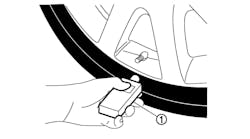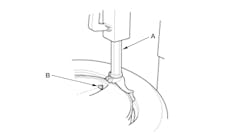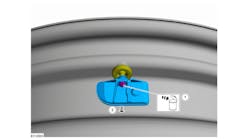In 2009, I was working on a 2000 Silverado with a technician from northern Minnesota. The Silverado had an anti-lock brake light on with a code C0235 stored. The technician said that the chart indicated it was a rear speed sensor code, but the truck doesn’t have rear speed sensors.
This is a good example of different systems sharing information. In this case, the speed sensor on the transmission or transfer case sends a signal to the powertrain control module (PCM), which then uses the reading for transmission shifting and other calculations. It also sends the reading to the dash cluster for speedometer and odometer operation as well as to the electronic brake control module (EBCM) for rear speed signal (the rear wheels are on one channel for braking unlike the front wheels that are controlled on two separate channels).
For the most part, there are two different ways modules share information:
1) to send the information to another module by way of data line, and
2) to use a dedicated wire, as in the case with our Silverado and the rear speed signal.
On the Silverado, the PCM has a yellow/black wire that sends a pulsed voltage signal to the EBCM. The EBCM counts the pulses to determine the rear wheel speed. Knowing how this information is transferred can help with diagnostics. The trouble code chart directs us to disconnect the EBCM and check voltage on the yellow/black wire. That is the clue to which direction the voltage is coming from.
Sometimes the sending module will produce a pulsing voltage. Other times the receiving module will send out voltage and the module sending the signal will pulse it to ground (this sounds more confusing than it is).
It will be very helpful to skim through the flow chart to try and determine which way the voltage is traveling. Be sure the flow chart is not asking you to check for voltage, only to have the next line say, “Repair the wire shorted to voltage.”
In the case of the Silverado, the PCM should put out about 10.0 volts to the EBCM. A quick voltage test at the EBCM revealed no voltage on the yellow/black wire. Next, the voltage at the PCM was tested and found to be 10.0 volts. Great -- a broken wire or bad connection. If there had been no voltage at the PCM as well, we would have tested the yellow/black wire for a short to ground or to another wire before condemning the PCM. Most of today’s cars and trucks are using shared information in as many systems as possible. This greatly reduces the cost and complexity of extra sensors, connections and miles of wiring, not to mention it can help shorten diagnostic time like it did on this Silverado. Seeing that the speedometer worked meant not having to check the speed sensor, reluctor, or wires and connections to the PCM.
We’ll be sure to keep sharing the latest information with you and as you share information back with us, it closes the loop to help pinpoint where the problem spots are on each vehicle.
(For information on Identifix, visit www.identifix.com.)




